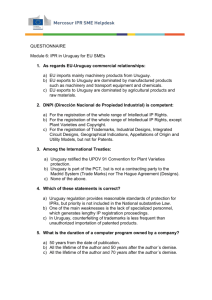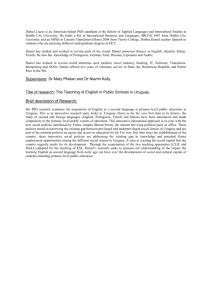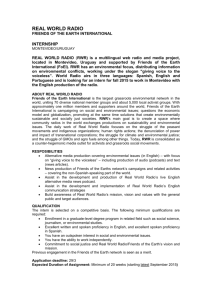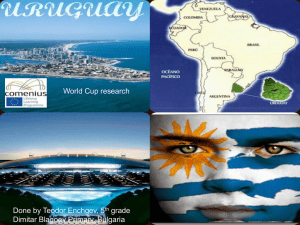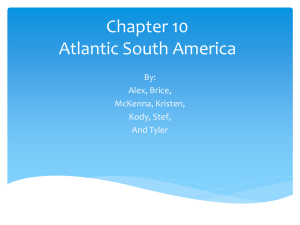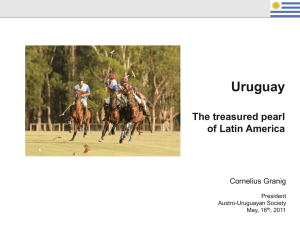Detailed Final Report - The Rufford Foundation
advertisement
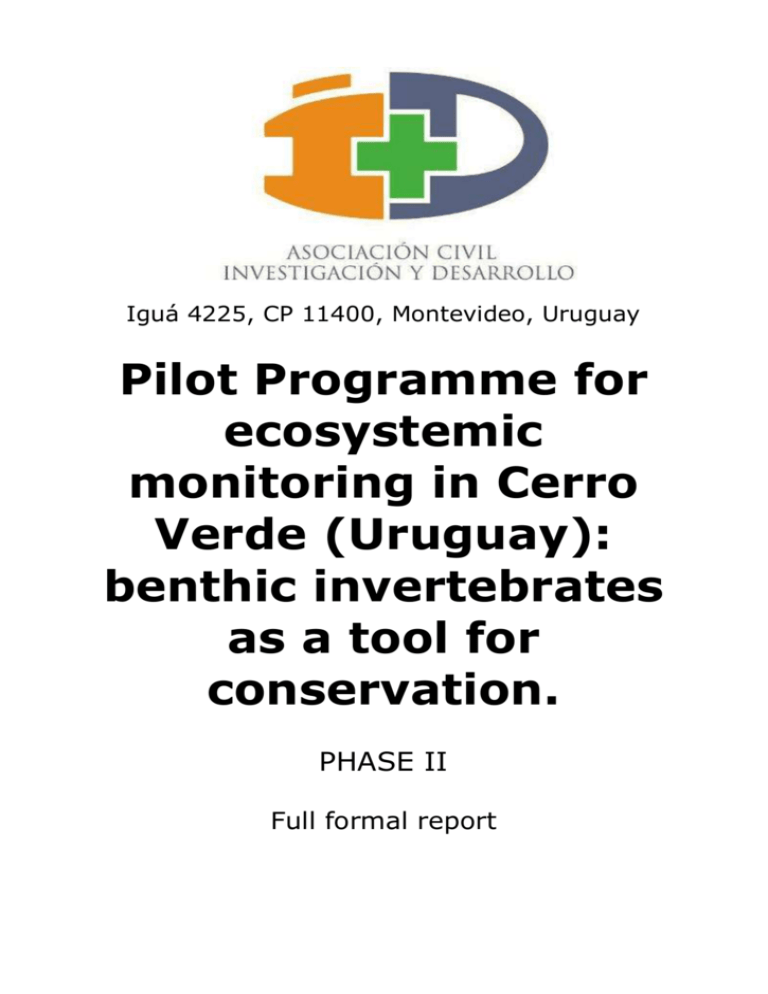
Iguá 4225, CP 11400, Montevideo, Uruguay Pilot Programme for ecosystemic monitoring in Cerro Verde (Uruguay): benthic invertebrates as a tool for conservation. PHASE II Full formal report Pilot Programme for ecosystemic monitoring in Cerro Verde (Uruguay): benthic invertebrates as a tool for conservation PHASE II MSc. A. Carranza EXECUTIVE SUMMARY The aim of this proposal was to complete baseline studies of biodiversity of benthic invertebrates at Cerro Verde, Uruguay. To this end, biological samples were taken seasonally, within a stratified sampling design in the soft bottoms, from the shallow subtidal (i.e. 3 m to 15 m). To date we completed nine extensive faunistic surveys, collecting more than 70 taxa of benthic invertebrates in the intertidal and subtidal zones of the study area. We are now working in the taxonomic determination of the species recorded, with the aid of specialists in the different taxa and local students. Some previously unreported species of invertebrates were found, increasing the knowledge about the coastal biodiversity of the Atlantic coast of Uruguay. Emerging knowledge will be of outmost importance in the development of managing strategies for this area, which is a well known feeding zone for several endangered vertebrate species. Products will allow detection of environmental impacts in a cheap and rapid way. Divulgation of the preliminary results were driven through presentation of several works in a local meeting in June 2007. Part of the information gathered during PHASE I was already published in mainstream scientific journals, and several more papers are in preparation. In addition, since Cerro Verde is in process of incorporation to the National System of Protected Areas (SNAP) as a first Pilot Protected Marine Area of the in Uruguay, the information here collected will be of utmost importance to strength the scientific basis for appropriate reserve management. BACKGROUND The increasing need for an adequate environmental management, triggered by the conspicuous degradation of coastal habitats worldwide, has raised awareness of the need for systematic research to assess biodiversity. The need is especially acute for the marine invertebrates, particularly groups that may be sensitive indicators of environmental change. In Uruguay, coastal marine fauna is far from being completely documented, with little or no systematic effort directed toward taxonomic surveys and inventories of marine invertebrates. This lack of focus is further aggravated by the shortage of experienced field systematists and taxonomists. Worldwide, the importance of detailed taxonomic inventories has been increasingly recognized, since these constitute the basis for the development of ecosystem monitoring programs and the detection of environmental degradation. In this context, fully protected marine reserves are an emerging tool for marine conservation and management. These areas may provide multiple benefits, including protection of habitat, conservation of biodiversity, insurance about environmental uncertainty and sites for scientific investigation, baseline information, education and recreation. However, data on several key ecological and life history features of marine reserves and communities are needed in order to select the placement and extent of an MPA (marine protected area). In this sense, the aim of this project is to determine benthic invertebrate specific richness in the intertidal and sub tidal zone, larval supply from the water column and annual cycles of studied fauna at Cerro Verde, Uruguay, in order to provide a baseline for the evaluation of environmental impacts and to contribute to the design of a MPA. STUDY AREA The biodiversity and productivity of the coastal ecoregion "Uruguay-Buenos Aires Shelf" (34°41° S), summed to the magnitude of anthropogenic activities (tourism, urbanisation, industrial and domestic effluents, fisheries), confer to this coastal ecoregion a high priority for conservation. Cerro Verde (33° 57'S, 53°30' W) is a rocky cape on the east coast of Uruguay affected by semidiurnal, low amplitude tides (range < 0.5 m) that are largely controlled by wind conditions (direction and speed). The rocky platforms have a smooth slope, with a width ranging from 15 to 23 m, and are exposed to different degrees of wave action according to its orientation. These platforms follow a classical zonation scheme, in which three zones can be identified: a high intertidal zone dominated by a cyan bacterial film, a middle intertidal zone dominated by barnacles and a low intertidal and shallow sub tidal zone characterized by a dense cover of mussels and/or macroalgae. This site harbours a rich hard-substrata benthic fauna, a yet non-defined number of fish species (e.g. endangered sharks Mustelus schmitti, M. fasciatus, Sphyrna bigelowi) and marine birds, mammals (Otaria bryonia, Arctocephalus australis) and sea turtles (Chelonya mydas). This site has recently been established as the first pilot marine protected area in Uruguay. For this purpose, quantitative data on species abundance, distribution, and temporal variation are of outmost importance in order to asses reserve effectiveness. In this context, our proposal was based on the urgent need for this relevant information. In this context, we developed a two years research programme in the area, focused in benthic invertebrates and its planktonic larval stages. This will allow us to assess benthic organism biodiversity and it’s dynamic at Cerro Verde, providing a baseline for the evaluation of environmental impacts and to contribute to the management of the MPA. THE TEAM Alvar Carranza is Uruguayan, 35 years old, MSc. in Ecology (2006), Facultad de Ciencias, Universidad de la República, is an advanced PhD. student of PEDECIBA (Basic Sciences Development Programme), since 2007. Previous work includes Project PNUD-GEF-RLA 99-G31 (FREPLATA). Ana Inés Borthagaray is Uruguayan and aged 31 years old. Four-year BSc, honours in Oceanography (2002), Facultad de Ciencias, Universidad de la República, ia also an advanced PhD. student, since 2006. Previous work includes collaboration with PPNUD-GEF-RLA 99G31 (FREPLATA). Fabrizio Scarabino is specialist in invertebrate taxonomy. He is currently working at the National Museum of Natural history (Montevideo) and National direction of Aquatic resources (DINARA). Dra. Estela Delgado is helping with crustacean biology. Dr. Gabriel Genzano (Universidad de Mar del Plata, Argentina) helped with identification of Pycnogonids. Michela Borges from Departamento de Zoología, Instituto de Biologia, UNICAMP, Sao Paulo, Brazil, helped with taxonomic determination of Ophiuroideans. Angel Segura and Luis Rubio are in charge of data processing and field work. Project “Karumbe-CIID”, an NGO working with sea turtles conservation and ecology in Uruguay provided facilities and contacts with the local community. This NGO is currently developing conservation projects in the Cerro Verde-La Coronilla area. (http://www.karumbe.8k.com/). Facultad de Ciencias, Universidad de la República, in agreement with the organisation I+D (“Investigación y Desarrollo”) is providing facilities for laboratory work. Voucher material is being deposited at the National Museum of Natural History. RESEARCH ACTIVITIES Field work The Field work was performed with the help of local fishermen and graduate and undergraduate students. Samplings were made onboard the artisanal fishing vessel “Dommy”, during January, May and September 2007. The fishing gears employed consisted in: a) a bottom trawl net (BTN) with a 9 m horizontal opening, 1.2 m high and a 25 mm stretched mesh in the cod ends and b) a Piccard epibenthic dredge (PEB), with a horizontal aperture of 60cm and 1cm mesh size. In each date some 9 stations were allocated based on a systematic stratified design, between the outer breakers and approximately 10-15 m depth (see map for details). In each station, 10 minutes tows were performed with the BTN, while 5 min tows were performed with the PEB. The exact location of the stations was determined by Garmin-Etrex Global Positioning System (GPS), depth was noticed using onboard ECOSONDA. Once landed, all benthic animals collected were fixed and taken to laboratory. Fish was also collected, and stomach contents kept for subsequent dietary analyses. Voucher material is deposited at the National Museum of Natural History, Montevideo (MNHNM). Laboratory work Organisms fixed were identified and counted in the laboratory. Taxonomic determination is being made for most of the macro faunal invertebrates collected since no comprehensive inventory of the benthic fauna is available yet. These imply the collaboration with regional researchers’ specialized in particular zoological groups, to avoid misidentifications and/or erroneous taxonomic determination. It is remarkable that at least three species were first recorded for the Uruguayan coast by means of this strategy (see attached material). PRELIMINARY RESULTS To date, we completed the surveys corresponding to summer, autumn, winter and spring 2007, collecting ca. 50 semi quantitative samples. During the first survey, (January 2007) we collected 13 macro invertebrate taxa, being the samples dominated by the crustaceans Loxopagurus loxochelis and Libinia espinosa (45, 31 and 26, 56% respectively of the collected were molluscs (Pachycymbiola brasiliana, Buccinanops cochlidium and B. duartei), cnidarians (Antholoba achates) and Echinodermata (Mellita quinquiesperforata). Two decapods species, Hepatus pudibundus and Araneus cribarius were also recorded, together with several species of peracariid crustaceans (Isopoda and Amphipoda). Based on prelim nary observations from the samples collected during the remaining surveys, it is estimated that at least 50 species of benthic macro invertebrates were recorded. In addition, individuals of 18 of bony fishes and 5 chondrictians were captured. From these, Mustelus schmitti Sympterygia acute are currently listed in the IUCN red list as endangered and threatened respectively. From 153 stomach contents analysed to date, representing 17 fish species, 92.6 % presented some content (Urophysis brasiliensis n=23 (100%), Paralonchurus brasiliensis n=18 (94.1%), Micropogonias furnieri n=31 (90.3%), Macrodon ancylodon n=29 (86.2%), Stromateus brasiliensis n=12 (91.7%) y Sympterygia acuta n=18 (94.1%). P. brasiliensis showed a high number of polychatetes, while S. brasiliensis showed preferences for small peracarid crustaceans (Mysida). The shrimp Artemesia longinaris was the main item in the remaining species, reaching 78.3% occurrence in Urophysis brasiliensis. The presence of amphipods and fish larvae (16% of occur in Macrodon ancylodon) was also registered. The hermit crab Loxopagurus loxochelis was preyed by Mustelus schmitti and Menticirrus americanus. Stellifer rastrifer, a coastal fish species that inhabits the Tropical and Southwestern Atlantic Ocean is reported for the first time from the Uruguayan Coast and its geographic distribution range is extended southward in more than 1200 km. A warm-circulation event in the zone is suggested as a putative factor explaining the occurrence of the fish in the area. RESULT DISSEMINATION The list of publications to date in peer-reviewed journals and edited books is listed below: 2007: CARRANZA, A, BORGES, M, RODRÍGUEZ, M & BORTHAGARAY, AI. Ophiuroidea (Echinodermata) from La Coronilla-Cerro Verde (Uruguay): a new record for the Uruguayan coast. Biota Neotropica, 7(3): http://www.biotaneotropica.org.br 2007: CARRANZA, A., BORTHAGARAY, A. I. & GENZANO, G. N. Two new records of pycnogonids on the Uruguayan coast. Brazilian Journal of Biology, 67 (2):373-375 2007: BORTHAGARAY, A. I. & CARRANZA, A. Mussels as ecosystem engineers: Their contribution to species richness in rocky littoral community. Acta Oecologica 31: 243-250 2007: CARRANZA, A. Pilot programme of ecosystem monitoring in Cerro Verde (Uruguay): two years of malacological assessment. Tentacle.The Newsletter of the IUCN/SSC Mollusc Specialist Group, 15: 22-23 2006: SCARABINO, F., ZAFFARONI, JC., CARRANZA, A., CLAVIJO, C. & NIN, M. Gasterópodos marinos y estuarinos de la costa uruguaya: faunística, distribución, taxonomía y conservación. Pp 143-155 En Bases para la conservación y el manejo de la costa uruguaya, Menafra R, Rodríguez-Gallego L, Scarabino F & Conde D (Eds), VIDA SILVESTRE (Sociedad Uruguaya para la Conservación de la Naturaleza), Montevideo 2006: SCARABINO, F., ZAFFARONI, JC., CLAVIJO, C., CARRANZA, A. & NIN, M. Bivalvos marinos y estuarinos de la costa uruguaya: faunística, distribución, taxonomía y conservación. pp 157-169 En Bases para la conservación y el manejo de la costa uruguaya, Menafra R, Rodríguez-Gallego L, Scarabino F & Conde D (Eds), VIDA SILVESTRE (Sociedad Uruguaya para la Conservación de la Naturaleza), Montevideo In press: CARRANZA, A., SEGURA, A., LÓPEZ, J. & RUBIO, L. Shell use patterns of the hermit crab Loxopagurus loxochelis (Decapoda: Diogenidae) in the Cerro Verde-La Coronilla marine protected area. Comunicaciones de la Sociedad Malacológica del Uruguay. In addition, we presented the following posters and abstracts in local meetings (local schools and university) and presentations in regional or local congresses. 2007: CARRANZA, A. Investigación, monitoreo y conservación: invertebrados bentónicos del area marina protegida de Cerro Verde (Rocha, Uruguay) IV Congreso Nacional de Áreas Protegidas, Trinidad, Uruguay. 2007: RUBIO, L., SEGURA, A. & CARRANZA, A. La comunidad nectónica en el área marina protegida de Cerro Verde. IV Congreso Nacional de Areas Protegidas, Trinidad, Uruguay 2005: CARRANZA, A., BORTHAGARAY, A. I. & GENZANO, G. N. Dos nuevos registros de Pycnogonida para aguas Uruguayas. VIII Jornadas de Zoología del Uruguay, Facultad de Ciencias, Montevideo, Uruguay. 2005: CARRANZA, A. & BORTHAGARAY, A. I. Los mejillones como ingenieros ecosistémicos: su contribución a la riqueza especifica en la comunidad del litoral rocoso. II Encuentro de Ecología del Uruguay, Facultad de Ciencias, Montevideo, Uruguay Final results will also be presented to the Uruguayan committee of the IUCN and all he people implicated, in different ways, in coastal management The field work was supported by The Rufford Small Grant Foundation. SCUBA divers Pablo Píriz and Jorge Duran and S. Horta,S. Sauco and Dr. Danilio Calliari are acknowledged for collaboration during field work.
